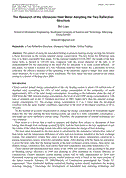p.1990
p.1995
p.2000
p.2004
p.2010
p.2014
p.2019
p.2023
p.2027
The Research of the Ultrasonic Heat Meter Adopting the Two Reflection Structure
Abstract:
The pattern of using the household billing to promote heating energy savings has become a focus discussion in the current national energy conservation. The key factor for following such way is to find a reasonable heat meter. To the national standard CJ128-2007, the length of the heat meter body is limited to 130/190 mm, compared with the actual diameter of the tube is 18 mm(standard20), the measuring of the small flux by ultrasonic is to some extend difficult. In this paper, we report a research of a two reflection structure flow meter. By a procedure of twice reflection, the effective distance of the spreading of the ultrasonic signal is longer than some other usual structures. So it can work in above conditions. The flow meter has been carried on the online testing in a district of Beijing since 2009.
Info:
Periodical:
Pages:
2010-2013
Citation:
Online since:
September 2011
Authors:
Price:
Permissions:
Сopyright:
© 2011 Trans Tech Publications Ltd. All Rights Reserved

